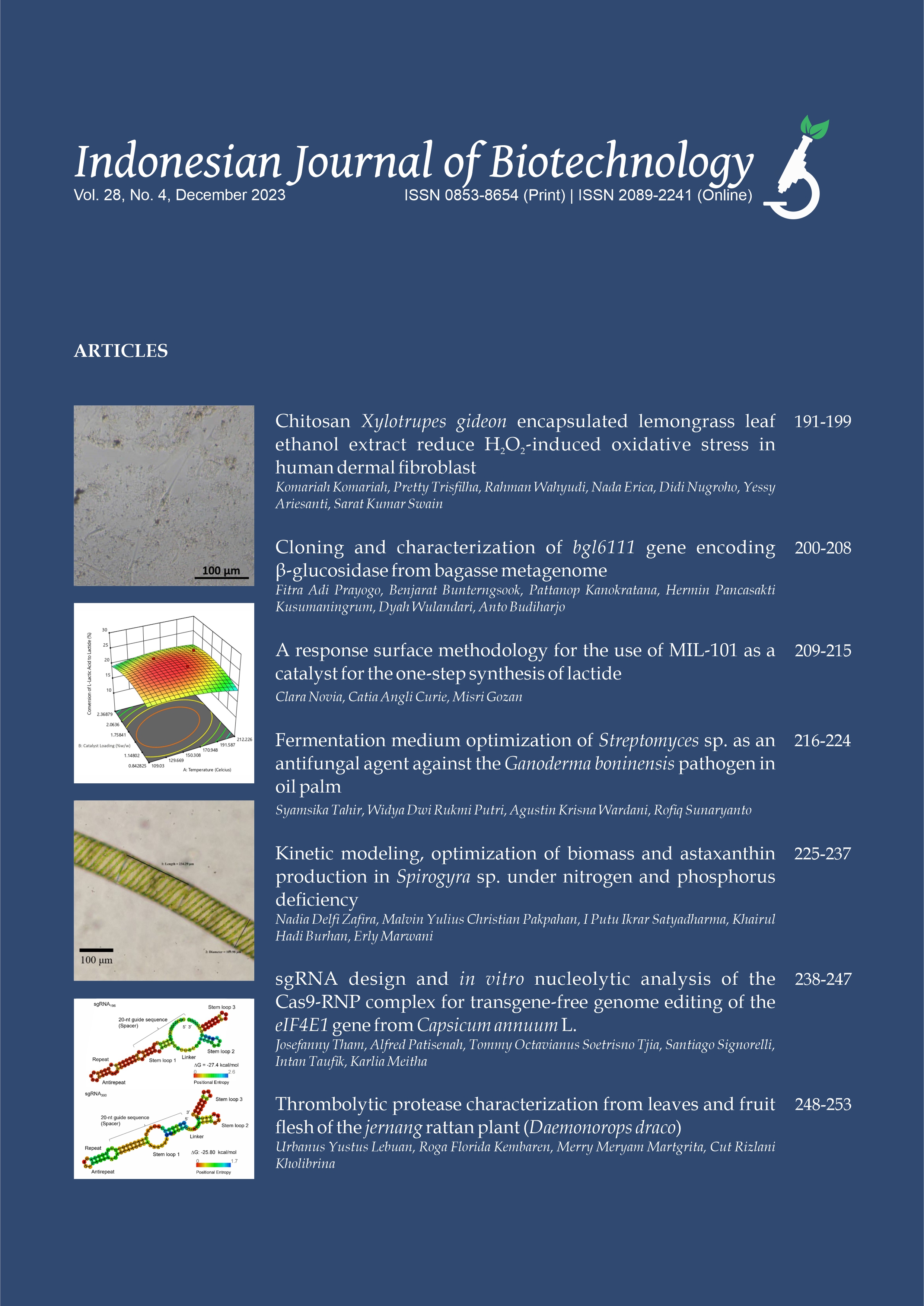Early detection of the orchid flowering gene PaFT1 in tobacco cells using a GFP reporter
Sri Wahyuningsih(1), Muhammad Dylan Lawrie(2), Budi Setiadi Daryono(3), Sukarti Moeljopawiro(4), Soenghoe Jang(5), Endang Semiarti(6*)
(1) Graduate Study Program of Biology, Faculty of Biology, Universitas Gadjah Mada, Jl. Teknika Selatan, Sekip Utara,Yogyakarta 55281, Indonesia
(2) Graduate Study Program of Biology, Faculty of Biology, Universitas Gadjah Mada, Jl. Teknika Selatan, Sekip Utara,Yogyakarta 55281, Indonesia
(3) Department of Tropical Biology, Faculty of Biology, Universitas Gadjah Mada, Yogyakarta, Indonesia
(4) Department of Tropical Biology, Faculty of Biology, Universitas Gadjah Mada, Yogyakarta, Indonesia
(5) Biotechnology Center in Southern Taiwan (BCST) of Agricultural Biotechnology Research Center (ABRC), Academia Sinica, Taiwan
(6) Department of Tropical Biology, Faculty of Biology, Universitas Gadjah Mada, Yogyakarta, Indonesia
(*) Corresponding Author
Abstract
Here we describe a novel method of using green fluorescence protein (GFP) as a reporter gene for early detection of an integrated TDNA containing the orchid flowering gene, PaFT1 (Phalaenopsis aphrodite Flowering locus T1) in the tobacco genome. Functional assays that report the presence of exogenous DNA early in development are especially useful in plants where the desired phenotype is only apparent after long periods of vegetative growth. The objective of this study is to establish a method for detecting an inserted Phalaenopsis orchid flowering gene and examining its function in tobacco. The p35S::PaFT1 35S::GFP construct was introduced into Agrobacterium tumefaciens strain EHA101. Transformed tobacco leaves were cultured on MS medium with addition of 1 mgL-1 NAA+3 mgL-1 BAP+50 mgL-1 Kanamycin+300 mgL-1 timentin for selection. Results showed bright green GFP fluorescent signals in 11 out of 15 (73%) tobacco leaf cells at a 2month time point after transformation. GFP and PaFT1 fragments were amplified in genomic PCR using GFP and PaFT1 specific primers. The accumulated PaFT1 transcripts were observed in 3 monthold transgenic tobacco plants containing p35S::PaFT135S::GFP. Green florescence was observed only in the transgenic plants at the 5 monthold stage but not in the wild type controls.
Keywords
Full Text:
PDFReferences
Brito, R.C.H., Carvalho, J.L., Zonari, A.A.C., Breyner, N.M., Carvalho, L., Gomes, D.A., and Goes, A.M. 2013. Genotype and expression of the enhanced green fluorescent protein in LEW-Tg (EGFP) F455.5/Rrrc rats. Braz. J. Vet. Res. Anim. Sci., 50, 2, 87-97.
Casali, N. 2003. Escherichia coli host strains. In E. coli Plasmid Vectors Methods and Applications (N. Casali and A. Preston, eds.) p 27. Humana Press, Inc.
Chai, D. and Yu, H. 2007. Recent Advances in Transgenic Orchid Production. Orchid Sci. Biotechnol., 1, 2, 34-39.
Ghorbel, R., Juarez, J., Navarro, L., and Pena, L. 1999. Green fluorescent protein as a screenable marker to increase the efficiency of generating transgenic woody fruit plants. Theor. Appl. Genet., 99, 350-358.
Hraska, M., Rakousky, S., and Curn, V. 2006. Green fluorescent protein as a vital marker for non-destructive detection of transformation events in transgenic plants. Plant Cell Tissue Organ Cult., 86, 303–318.
Jang, S., Choi, S-C, Li, H-Y.,2, An, G., Schmelzer, E., 2015. Functional Characterization of Phalaenopsis aphrodite Flowering Genes PaFT1 and PaFD. PLoS ONE 10(8): e0134987. doi:10.1371/journal pone.0134987
Julkiflie, A.L., Rathinam, X., Sinniah, U.R., and Subramaniam, S. 2010. Optimisation of Transient Green Fluorescent Protein (GFP) Gene Expression in Phalaenopsis Violacea Orchid Mediated by Agrobacterium Tumefaciens-mediated Transformation System. Australian Journal of Basic and Applied Sciences. 4, 8, 3424-3432.
Ko, T. and Korban, S. 2004. Enhancing the frequency of somatic embyogenesis following Agrobacterium-mediated transformation of immature cotyledons of soybean (Glycine max (L.) Merrill). In Vitro Cell Dev. Biol-Plant., 40, 552-558
Kojima, S., Banno, H., Yoshioka, Y., Oka, A., Machida, C., and Machida, Y. 1999. A binary vector plasmid for gene expression in plant cells that is stably maintained in Agrobacterium cells. DNA Research, 6, 407-410.
Madigan, M.T., Martinko, J.M., Stahl, D.A., and Clark, D.P. (2012) Brock Biology of Microorganisms. San Francisco: Pearson Education, Inc. p 160.
Miki, B., and McHugh, S. 2004. Selectable marker genes in transgenic plants: applications, alternatives and biosafety. J. Biotechnol., 107, 193–232.
Mohammed, A., and Abalaka, M. E. 2011. Agrobacterium transformation: A boost to agricultural Biotechnology. J. Med. Genet. Genomics., 3, 8, 126 – 130.
Puchta, H. 2003. Marker-free transgenic plants. Plant Cell, Tissue and Organ Cult., 74, 123–134.
Saijo, T. and Nagasawa, A. 2015. A new detection tool for bioavailable copper utilizing transgenic plants carrying recombinant yeast ACE1 transcription factor and GFP reporter genes. Soil Science and Plant Nutrition. 61, 281–286
Sambrook, J., and Russell, D.W. (2001) Molecular Cloning. New York: Cold Spring Harbor Laboratory Press. p 8.18.
Semiarti, E., Indrianto, A., Purwantoro, A., Martiwi, I.N.A., Feroniasanti, Y.M.L., Nadifah, F., Mercuriani, I.S., Dwiyani, R., Iwakawa, H., Yoshioka, Y., Machida, Y., and Machida, C. (2010). High-frequency genetic transformation of Phalaenopsis amabilis orchid using tomato extract-enriched medium for the pre-culture of protocorms. Journal of Horticultural Science and Biotechnology, 85, 3, 205-210
Stewart, C. N. Jr. 2005. Monitoring the presence and expression of transgenes in living plants. Trends Plant Sci., 10, 8, 390-396.
Widyasari, W. B, and Suhandono, S. 2007. Konstruksi vektor biner untuk ekspresi gen dipp22 (yang diisolasi dari tebu varietas M 442-51) pada tanaman. Berk. Penel. Hayati, 13, 15-26.
Xia, N., Luo,W., Zhang, J., Xie, X., Yang, H., Li, S., Chen, M., and Ng, M. 2002. Bioluminescence of Aequorea macrodactyla, a Common Jellyfish Species in the East China Sea. Mar. Biotechnol, 4, 155–162.
Xu, F., Rong, X., Huang, X., and Cheng, S. 2012. Recent Advances of Flowering Locus T Gene in Higher Plants. Int. J. Mol. Sci., 13, 3773-3781.
Yuwono, T. (2006) Bioteknologi Pertanian. Yogyakarta: Gadjah Mada University Press. pp 14, 217.Article Metrics
Refbacks
- There are currently no refbacks.
Copyright (c) 2016 The Author(s)

This work is licensed under a Creative Commons Attribution-ShareAlike 4.0 International License.









